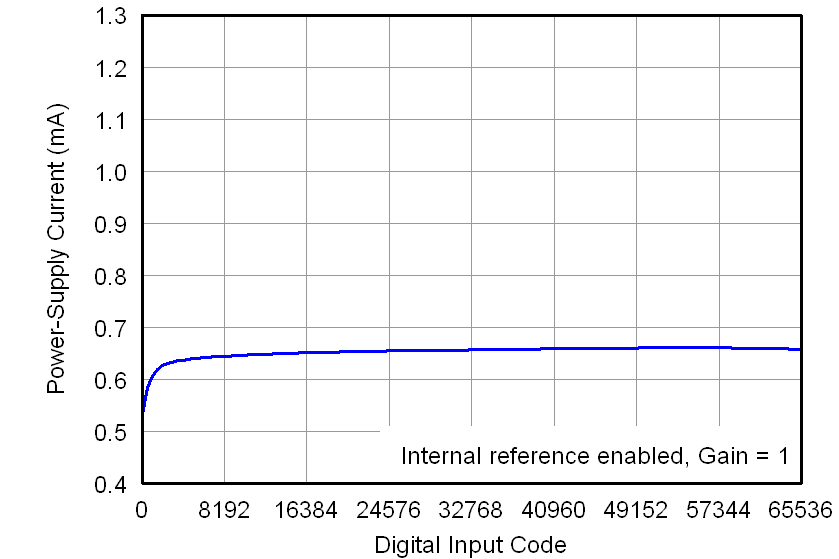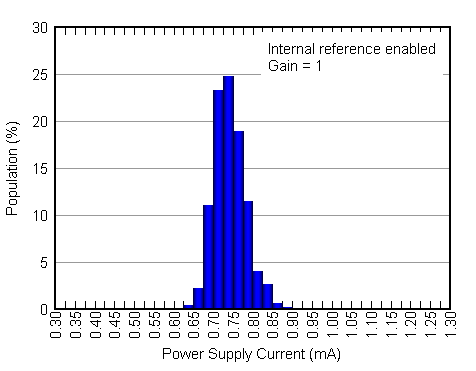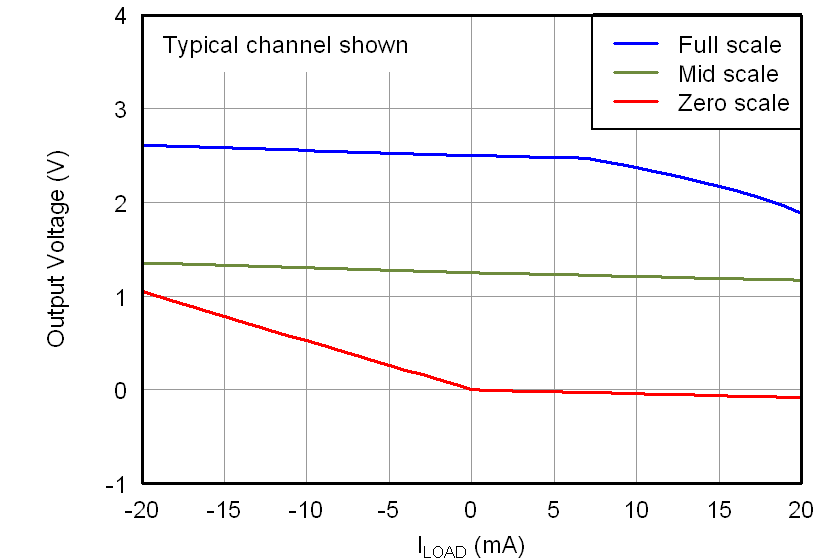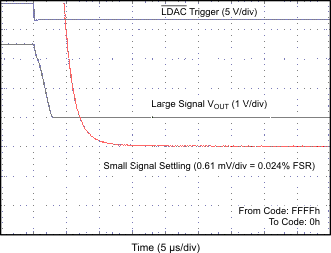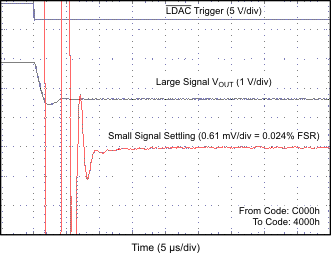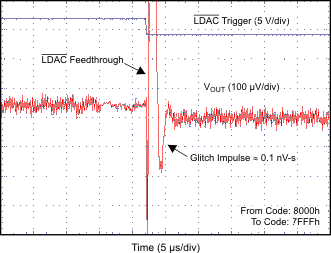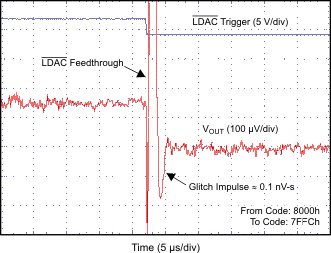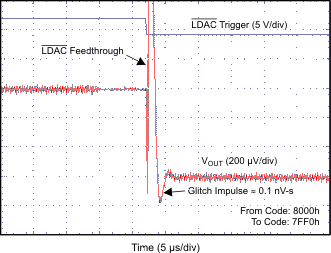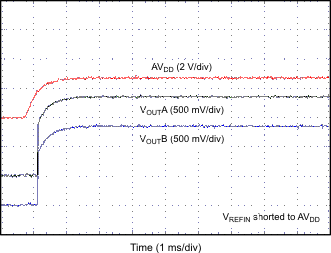ZHCSE89A September 2015 – October 2015 DAC7562T , DAC7563T , DAC8162T , DAC8163T , DAC8562T , DAC8563T
PRODUCTION DATA.
- 1 特性
- 2 应用
- 3 说明
- 4 修订历史记录
- 5 Device Comparison Table
- 6 Pin Configuration and Functions
- 7 Specifications
- 8 Detailed Description
- 9 Application and Implementation
- 10Power Supply Recommendations
- 11Layout
- 12器件和文档支持
- 13机械、封装和可订购信息
封装选项
机械数据 (封装 | 引脚)
散热焊盘机械数据 (封装 | 引脚)
- DSC|10
订购信息
7 Specifications
7.1 Absolute Maximum Ratings(1)
Over operating ambient temperature range (unless otherwise noted).| MIN | MAX | UNIT | ||
|---|---|---|---|---|
| AVDD to GND | –0.3 | 6 | V | |
| CLR, DIN, LDAC, SCLK and SYNC input voltage to GND | –0.3 | AVDD + 0.3 | V | |
| VOUT[A, B] to GND | –0.3 | AVDD + 0.3 | V | |
| VREFIN/VREFOUT to GND | –0.3 | AVDD + 0.3 | V | |
| Operating temperature range | –40 | 125 | °C | |
| Junction temperature, TJ | 150 | °C | ||
| Storage temperature, Tstg | –65 | 150 | °C | |
(1) Stresses beyond those listed under Absolute Maximum Ratings may cause permanent damage to the device. These are stress ratings only, and do not imply functional operation of the device at these or any other conditions beyond those indicated under Recommended Operating Conditions. Exposure to absolute-maximum-rated conditions for extended periods may affect device reliability.
7.2 ESD Ratings
| VALUE | UNIT | |||
|---|---|---|---|---|
| V(ESD) | Electrostatic discharge | Human-body model (HBM), per ANSI/ESDA/JEDEC JS-001(1) | ±1000 | V |
| Charged-device model (CDM), per JEDEC specification JESD22-C101(2) | ±500 | |||
(1) JEDEC document JEP155 states that 500-V HBM allows safe manufacturing with a standard ESD control process.
(2) JEDEC document JEP157 states that 250-V CDM allows safe manufacturing with a standard ESD control process.
7.3 Recommended Operating Conditions
over operating ambient temperature range (unless otherwise noted)| MIN | NOM | MAX | UNIT | ||||
|---|---|---|---|---|---|---|---|
| POWER SUPPLY | |||||||
| Supply voltage | AVDD to GND | 2.7 | 5.5 | V | |||
| DIGITAL INPUTS | |||||||
| Digital input voltage | CLR, DIN, LDAC, SCLK and SYNC | 0 | AVDD | V | |||
| REFERENCE INPUT | |||||||
| VREFIN | Reference input voltage | 0 | AVDD | V | |||
| TEMPERATURE RANGE | |||||||
| TA | Operating ambient temperature | –40 | 125 | °C | |||
7.4 Thermal Information
| THERMAL METRIC | DAC756xT, DAC816xT, DAC856xT | UNIT | ||
|---|---|---|---|---|
| DSC (WSON) | DGS (VSSOP) | |||
| 10 PINS | 10 PINS | |||
| RθJA | Junction-to-ambient thermal resistance | 62.8 | 173.8 | °C/W |
| RθJC(top) | Junction-to-case (top) thermal resistance | 44.3 | 48.5 | °C/W |
| RθJB | Junction-to-board thermal resistance | 26.5 | 79.9 | °C/W |
| ψJT | Junction-to-top characterization parameter | 0.4 | 1.7 | °C/W |
| ψJB | Junction-to-board characterization parameter | 25.5 | 68.4 | °C/W |
| RθJC(bot) | Junction-to-case (bottom) thermal resistance | 46.2 | N/A | °C/W |
7.5 Electrical Characteristics
At AVDD = 2.7 V to 5.5 V and TA = –40°C to 125°C (unless otherwise noted).| PARAMETER | TEST CONDITIONS | MIN | TYP | MAX | UNIT | |
|---|---|---|---|---|---|---|
| STATIC PERFORMANCE(1) | ||||||
| DAC756xT | Resolution | 12 | Bits | |||
| Relative accuracy | Using line passing through codes 32 and 4,064 | ±0.3 | ±0.75 | LSB | ||
| Differential nonlinearity | 12-bit monotonic | ±0.05 | ±0.25 | |||
| DAC816xT | Resolution | 14 | Bits | |||
| Relative accuracy | Using line passing through codes 128 and 16,256 | ±1 | ±3 | LSB | ||
| Differential nonlinearity | 14-bit monotonic | ±0.1 | ±0.5 | |||
| DAC856xT | Resolution | 16 | Bits | |||
| Relative accuracy | Using line passing through codes 512 and 65,024 | ±4 | ±12 | LSB | ||
| Differential nonlinearity | 16-bit monotonic | ±0.2 | ±1 | |||
| Offset error | Extrapolated from two-point line(1), unloaded | ±1 | ±4 | mV | ||
| Offset error drift | ±2 | µV/°C | ||||
| Full-scale error | DAC register loaded with all 1s, DAC output unloaded | ±0.03 | ±0.2 | % FSR | ||
| Zero-code error | DAC register loaded with all 0s, DAC output unloaded | 1 | 4 | mV | ||
| Zero-code error drift | ±2 | µV/°C | ||||
| Gain error | Extrapolated from two-point line(1), unloaded | ±0.01 | ±0.15 | % FSR | ||
| Gain temperature coefficient | ±1 | ppm FSR/°C | ||||
| OUTPUT CHARACTERISTICS(2) | ||||||
| Output voltage range | 0 | AVDD | V | |||
| Output voltage settling time(3) | DACs unloaded | 7 | µs | |||
| RL = 1 MΩ | 10 | |||||
| Slew rate | Measured between 20%–80% of a full-scale transition | 0.75 | V/µs | |||
| Capacitive load stability | RL = ∞ | 1 | nF | |||
| RL = 2 kΩ | 3 | |||||
| Code-change glitch impulse | 1-LSB change around major carry | 0.1 | nV-s | |||
| Digital feedthrough | SCLK toggling, SYNC high | 0.1 | nV-s | |||
| Power-on glitch impulse | RL = 2 kΩ, CL = 470 pF, AVDD = 5.5 V | 40 | mV | |||
| Channel-to-channel dc crosstalk | Full-scale swing on adjacent channel, External reference |
5 | µV | |||
| Full-scale swing on adjacent channel, Internal reference |
15 | |||||
| DC output impedance | At mid-scale input | 5 | Ω | |||
| Short-circuit current | DAC outputs at full-scale, DAC outputs shorted to GND | 40 | mA | |||
| Power-up time, including settling time | Coming out of power-down mode | 50 | µs | |||
| AC PERFORMANCE(2) | ||||||
| DAC output noise density | TA = 25°C, at mid-scale input, fOUT = 1 kHz | 90 | nV/√Hz | |||
| DAC output noise | TA = 25°C, at mid-scale input, 0.1 Hz to 10 Hz | 2.6 | µVPP | |||
| LOGIC INPUTS(2) | ||||||
| Input-pin leakage current | –1 | ±0.1 | 1 | µA | ||
| Logic input LOW voltage VIL | 0 | 0.8 | V | |||
| Logic input HIGH voltage VIH | 2.1 | AVDD | V | |||
| Pin capacitance | 3 | pF | ||||
| REFERENCE | ||||||
| External reference current | External VREF = 2.5 V (when internal reference is disabled), all channels active using gain = 1 | 15 | µA | |||
| Reference input impedance | Internal reference disabled, gain = 1 | 170 | kΩ | |||
| Internal reference disabled, gain = 2 | 85 | |||||
| REFERENCE OUTPUT | ||||||
| Output voltage | TA = 25°C | 2.495 | 2.5 | 2.505 | V | |
| Initial accuracy | TA = 25°C | –5 | ±0.1 | 5 | mV | |
| Output-voltage temperature drift | Internal reference output voltage temperature drift is characterized from –40°C to 125°C. | 4 | 10 | ppm/°C | ||
| Output-voltage noise | f = 0.1 Hz to 10 Hz | 12 | µVPP | |||
| Output-voltage noise density (high-frequency noise) | TA = 25°C, f = 1 kHz, CL = 0 µF | 250 | nV/√Hz | |||
| TA = 25°C, f = 1 MHz, CL = 0 µF | 30 | |||||
| TA = 25°C, f = 1 MHz, CL = 4.7 µF | 10 | |||||
| Load regulation, sourcing(4) | TA = 25°C | 20 | µV/mA | |||
| Load regulation, sinking(4) | TA = 25°C | 185 | µV/mA | |||
| Output-current load capability(2) | ±20 | mA | ||||
| Line regulation | TA = 25°C | 50 | µV/V | |||
| Long-term stability or drift (aging)(4) | TA = 25°C, time = 0 to 1900 hours | 100 | ppm | |||
| Thermal hysteresis(4) | First cycle | 200 | ppm | |||
| Additional cycles | 50 | |||||
| POWER REQUIREMENTS(5) | ||||||
| Power supply current (IDD) | AVDD = 3.6 V to 5.5 V, normal mode, internal reference off, Digital inputs at VDD or GND | 0.25 | 0.5 | mA | ||
| AVDD = 3.6 V to 5.5 V, normal mode, internal reference off, Digital inputs at TTL level | 4 | |||||
| AVDD = 3.6 V to 5.5 V, normal mode, internal reference on, Digital inputs at VDD or GND | 0.9 | 1.6 | ||||
| AVDD = 3.6 V to 5.5 V, normal mode, internal reference on, Digital inputs at TTL level | 5 | |||||
| AVDD = 3.6 V to 5.5 V, power-down modes, Digital inputs at VDD or GND | 0.55 | 4 | µA | |||
| AVDD = 2.7 V to 3.6 V, normal mode, internal reference off, Digital inputs at VDD or GND | 0.2 | 0.4 | mA | |||
| AVDD = 2.7 V to 3.6 V, normal mode, internal reference off, Digital inputs at TTL level | 0.8 | |||||
| AVDD = 2.7 V to 3.6 V, normal mode, internal reference on, Digital inputs at VDD or GND | 0.73 | 1.4 | ||||
| AVDD = 2.7 V to 3.6 V, normal mode, internal reference on, Digital inputs at TTL level | 1.8 | |||||
| AVDD = 2.7 V to 3.6 V, power-down modes, Digital inputs at VDD or GND | 0.35 | 3 | µA | |||
| Power dissipation | AVDD = 3.6 V to 5.5 V, normal mode, internal reference off, Digital inputs at VDD or GND | 0.9 | 2.75 | mW | ||
| AVDD = 3.6 V to 5.5 V, normal mode, internal reference on, Digital inputs at VDD or GND | 3.2 | 8.8 | ||||
| AVDD = 3.6 V to 5.5 V, power-down modes, Digital inputs at VDD or GND | 2 | 22 | µW | |||
| AVDD = 2.7 V to 3.6 V, normal mode, internal reference off, Digital inputs at VDD or GND | 0.54 | 1.44 | mW | |||
| AVDD = 2.7 V to 3.6 V, normal mode, internal reference on, Digital inputs at VDD or GND | 1.97 | 5 | ||||
| AVDD = 2.7 V to 3.6 V, power-down modes, Digital inputs at VDD or GND | 0.95 | 10.8 | µW | |||
(1) 16-bit: codes 512 and 65,024; 14-bit: codes 128 and 16,256; 12-bit: codes 32 and 4,064, All digital inputs kept at same IO levels before and after write to the DAC
(2) Specification based on design or characterization
(3) Transition time between 1 / 4 scale and 3 / 4 scale, including settling to within ±0.024% FSR
(4) See the Application Information section of this data sheet.
(5) Input code = mid-scale, no load
7.6 Timing Requirements(1)(2)
At AVDD = 2.7 V to 5.5 V, external VREFIN = 2.5 V to 5.5 V, and over –40°C to 125°C (unless otherwise noted). See Figure 1.| DAC756xT, DAC816xT, DAC856xT | UNIT | ||||
|---|---|---|---|---|---|
| MIN | TYP | MAX | |||
| f(SCLK) | Serial clock frequency | 50 | MHz | ||
| t(1) | SCLK falling edge to SYNC falling edge (for successful write operation) | 10 | ns | ||
| t(2) | SCLK cycle time | 20 | ns | ||
| t(3) | SYNC rising edge to 23rd SCLK falling edge (for successful SYNC interrupt) | 13 | ns | ||
| t(4) | Minimum SYNC HIGH time | 15 | ns | ||
| t(5) | SYNC to SCLK falling edge setup time | 13 | ns | ||
| t(6) | SCLK LOW time | 8 | ns | ||
| t(7) | SCLK HIGH time | 8 | ns | ||
| t(8) | SCLK falling edge to SYNC rising edge | 10 | ns | ||
| t(9) | Data setup time | 6 | ns | ||
| t(10) | Data hold time | 6 | ns | ||
| t(11) | SCLK falling edge to LDAC falling edge for asynchronous LDAC update mode | 5 | ns | ||
| t(12) | LDAC pulse duration, LOW time | 10 | ns | ||
| t(13) | CLR pulse duration, LOW time | 80 | ns | ||
| t(14) | CLR falling edge to start of VOUT transition | 100 | ns | ||
(1) All input signals are specified with tr = tf = 1 ns/V (10% to 90% of AVDD) and timed from a voltage level of (VIL + VIH) / 2.
(2) See the Serial Write Operation timing diagram (Figure 1).
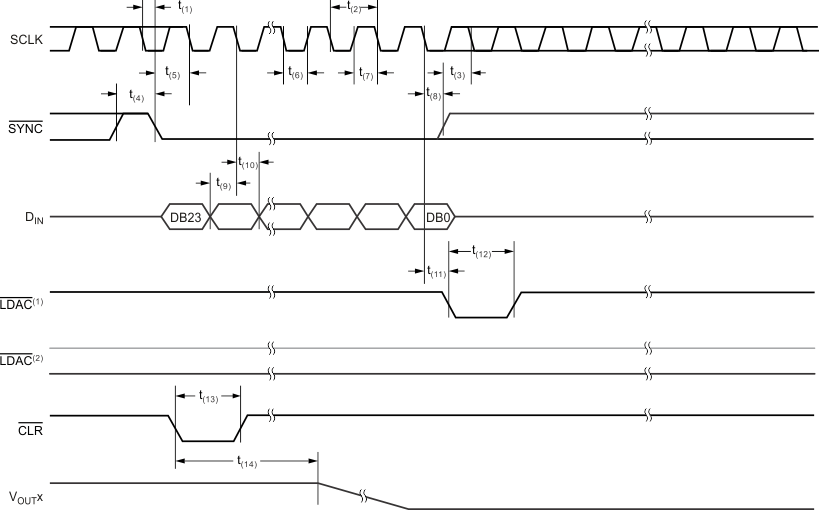
1. Asynchronous LDAC update mode. For more information, see the LDAC Functionality section.
2. Synchronous LDAC update mode; LDAC remains low. For more information, see the LDAC Functionality section.
Figure 1. Timing Diagram, Serial Write Operation
7.7 Typical Characteristics
Table 1. Typical Characteristics: Internal Reference Performance
| MEASUREMENT | POWER-SUPPLY VOLTAGE | FIGURE NUMBER | |
|---|---|---|---|
| Internal Reference Voltage vs Temperature | 5.5 V | Figure 2 | |
| Internal Reference Voltage Temperature Drift Histogram | Figure 3 | ||
| Internal Reference Voltage vs Load Current | Figure 4 | ||
| Internal Reference Voltage vs Time | Figure 5 | ||
| Internal Reference Noise Density vs Frequency | Figure 6 | ||
| Internal Reference Voltage vs Supply Voltage | 2.7 V–5.5 V | Figure 7 | |
Table 2. Typical Characteristics: DAC Static Performance
| MEASUREMENT | POWER-SUPPLY VOLTAGE | FIGURE NUMBER | |
|---|---|---|---|
| FULL-SCALE, GAIN, OFFSET AND ZERO-CODE ERRORS | |||
| Full-Scale Error vs Temperature | 5.5 V | Figure 16 | |
| Gain Error vs Temperature | Figure 17 | ||
| Offset Error vs Temperature | Figure 18 | ||
| Zero-Code Error vs Temperature | Figure 19 | ||
| Full-Scale Error vs Temperature | 2.7 V | Figure 63 | |
| Gain Error vs Temperature | Figure 64 | ||
| Offset Error vs Temperature | Figure 65 | ||
| Zero-Code Error vs Temperature | Figure 66 | ||
| LOAD REGULATION | |||
| DAC Output Voltage vs Load Current | 5.5 V | Figure 30 | |
| 2.7 V | Figure 74 | ||
| DIFFERENTIAL NONLINEARITY ERROR | |||
| Differential Linearity Error vs Digital Input Code | T = –40°C | 5.5 V | Figure 9 |
| T = 25°C | Figure 11 | ||
| T = 125°C | Figure 13 | ||
| Differential Linearity Error vs Temperature | Figure 15 | ||
| Differential Linearity Error vs Digital Input Code | T = –40°C | 2.7 V | Figure 56 |
| T = 25°C | Figure 58 | ||
| T = 125°C | Figure 60 | ||
| Differential Linearity Error vs Temperature | Figure 62 | ||
| INTEGRAL NONLINEARITY ERROR (RELATIVE ACCURACY) | |||
| Linearity Error vs Digital Input Code | T = –40°C | 5.5 V | Figure 8 |
| T = 25°C | Figure 10 | ||
| T = 125°C | Figure 12 | ||
| Linearity Error vs Temperature | Figure 14 | ||
| Linearity Error vs Digital Input Code | T = –40°C | 2.7 V | Figure 55 |
| T = 25°C | Figure 57 | ||
| T = 125°C | Figure 59 | ||
| Linearity Error vs Temperature | Figure 61 | ||
| POWER-DOWN CURRENT | |||
| Power-Down Current vs Temperature | 5.5 V | Figure 28 | |
| Power-Down Current vs Power-Supply Voltage | 2.7 V – 5.5 V | Figure 29 | |
| Power-Down Current vs Temperature | 2.7 V | Figure 73 | |
| POWER-SUPPLY CURRENT | |||
| Power-Supply Current vs Temperature | External VREF | 5.5 V | Figure 20 |
| Internal VREF | Figure 21 | ||
| Power-Supply Current vs Digital Input Code | External VREF | Figure 22 | |
| Internal VREF | Figure 23 | ||
| Power-Supply Current Histogram | External VREF | Figure 24 | |
| Internal VREF | Figure 25 | ||
| Power-Supply Current vs Power-Supply Voltage | External VREF | 2.7 V – 5.5 V | Figure 26 |
| Internal VREF | Figure 27 | ||
| Power-Supply Current vs Temperature | External VREF | 3.6 V | Figure 49 |
| Internal VREF | Figure 50 | ||
| Power-Supply Current vs Digital Input Code | External VREF | Figure 51 | |
| Internal VREF | Figure 52 | ||
| Power-Supply Current Histogram | External VREF | Figure 53 | |
| Internal VREF | Figure 54 | ||
| Power-Supply Current vs Temperature | External VREF | 2.7 V | Figure 67 |
| Internal VREF | Figure 68 | ||
| Power-Supply Current vs Digital Input Code | External VREF | Figure 69 | |
| Internal VREF | Figure 70 | ||
| Power-Supply Current Histogram | External VREF | Figure 71 | |
| Internal VREF | Figure 72 | ||
Table 3. Typical Characteristics: DAC Dynamic Performance
| MEASUREMENT | POWER-SUPPLY VOLTAGE | FIGURE NUMBER | |
|---|---|---|---|
| CHANNEL-TO-CHANNEL CROSSTALK | |||
| Channel-to-Channel Crosstalk | 5-V Rising Edge | 5.5 V | Figure 43 |
| 5-V Falling Edge | Figure 44 | ||
| CLOCK FEEDTHROUGH | |||
| Clock Feedthrough | 500 kHz, Midscale | 5.5 V | Figure 48 |
| 2.7 V | Figure 87 | ||
| GLITCH IMPULSE | |||
| Glitch Impulse, 1-LSB Step | Rising Edge, Code 7FFFh to 8000h | 5.5 V | Figure 37 |
| Falling Edge, Code 8000h to 7FFFh | Figure 38 | ||
| Glitch Impulse, 4-LSB Step | Rising Edge, Code 7FFCh to 8000h | Figure 39 | |
| Falling Edge, Code 8000h to 7FFCh | Figure 40 | ||
| Glitch Impulse, 16-LSB Step | Rising Edge, Code 7FF0h to 8000h | Figure 41 | |
| Falling Edge, Code 8000h to 7FF0h | Figure 42 | ||
| Glitch Impulse, 1-LSB Step | Rising Edge, Code 7FFFh to 8000h | 2.7 V | Figure 79 |
| Falling Edge, Code 8000h to 7FFFh | Figure 80 | ||
| Glitch Impulse, 4-LSB Step | Rising Edge, Code 7FFCh to 8000h | Figure 81 | |
| Falling Edge, Code 8000h to 7FFCh | Figure 82 | ||
| Glitch Impulse, 16-LSB Step | Rising Edge, Code 7FF0h to 8000h | Figure 83 | |
| Falling Edge, Code 8000h to 7FF0h | Figure 84 | ||
| NOISE | |||
| DAC Output Noise Density vs Frequency | External VREF | 5.5 V | Figure 45 |
| Internal VREF | Figure 46 | ||
| DAC Output Noise 0.1 Hz to 10 Hz | External VREF | Figure 47 | |
| POWER-ON GLITCH | |||
| Power-On Glitch | Reset to Zero Scale | 5.5 V | Figure 35 |
| Reset to Midscale | Figure 36 | ||
| Reset to Zero Scale | 2.7 V | Figure 85 | |
| Reset to Midscale | Figure 86 | ||
| SETTLING TIME | |||
| Full-Scale Settling Time | Rising Edge, Code 0h to FFFFh | 5.5 V | Figure 31 |
| Falling Edge, Code FFFFh to 0h | Figure 32 | ||
| Half-Scale Settling Time | Rising Edge, Code 4000h to C000h | Figure 33 | |
| Falling Edge, Code C000h to 4000h | Figure 34 | ||
| Full-Scale Settling Time | Rising Edge, Code 0h to FFFFh | 2.7 V | Figure 75 |
| Falling Edge, Code FFFFh to 0h | Figure 76 | ||
| Half-Scale Settling Time | Rising Edge, Code 4000h to C000h | Figure 77 | |
| Falling Edge, Code C000h to 4000h | Figure 78 | ||
7.7.1 Typical Characteristics: Internal Reference
At TA = 25°C, AVDD = 5.5 V, gain = 2, and VREFOUT unloaded, unless otherwise noted.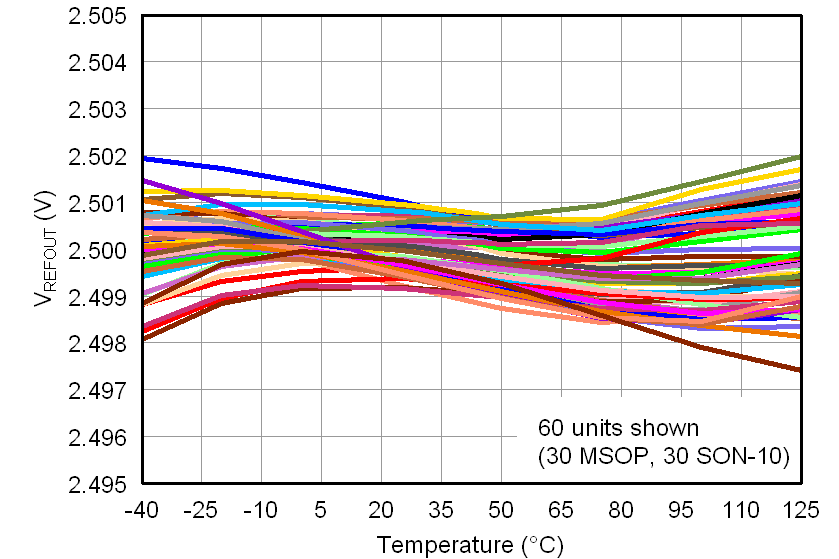

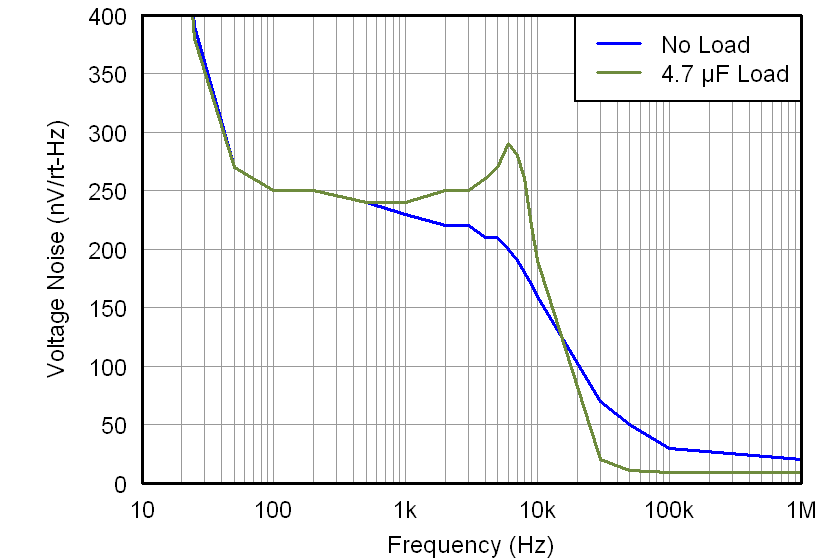
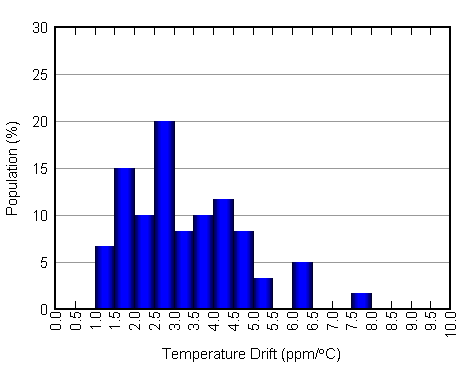


7.7.2 Typical Characteristics: DAC at AVDD = 5.5 V
At TA = 25°C, 5-V external reference used, gain = 1 and DAC output not loaded, unless otherwise noted..png)
.png)
.png)
.png)
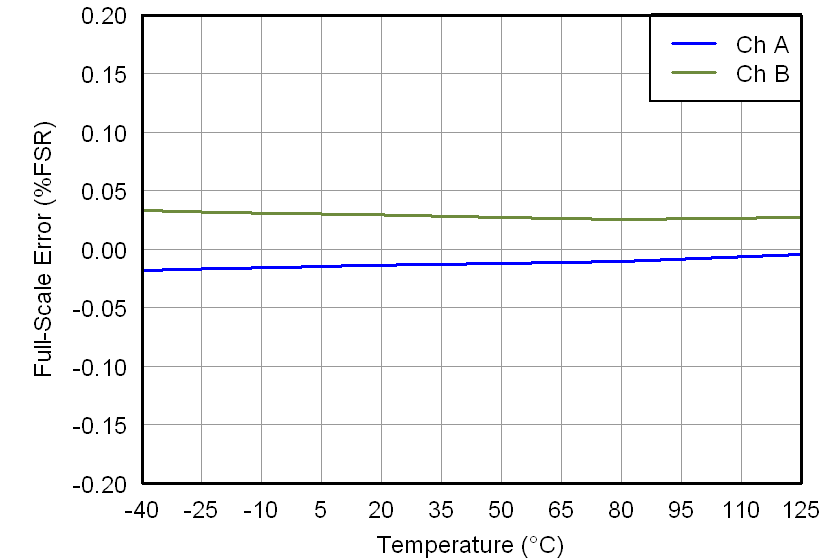
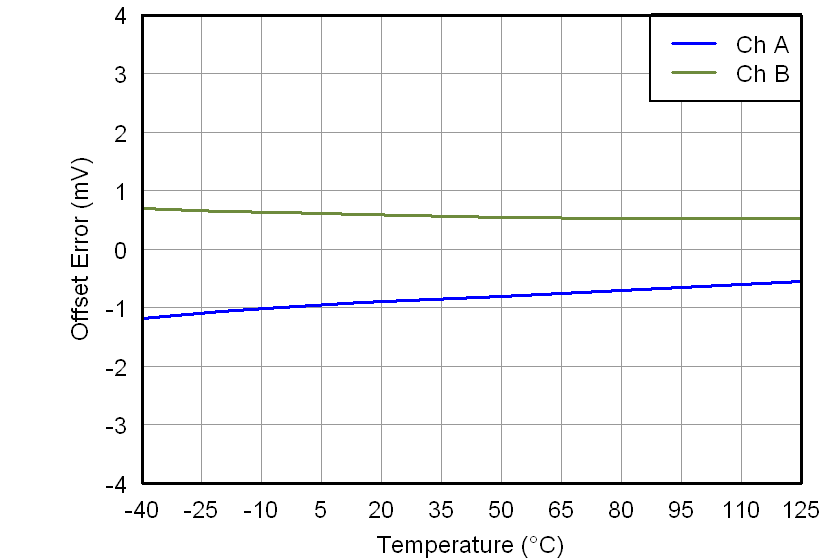
.png)
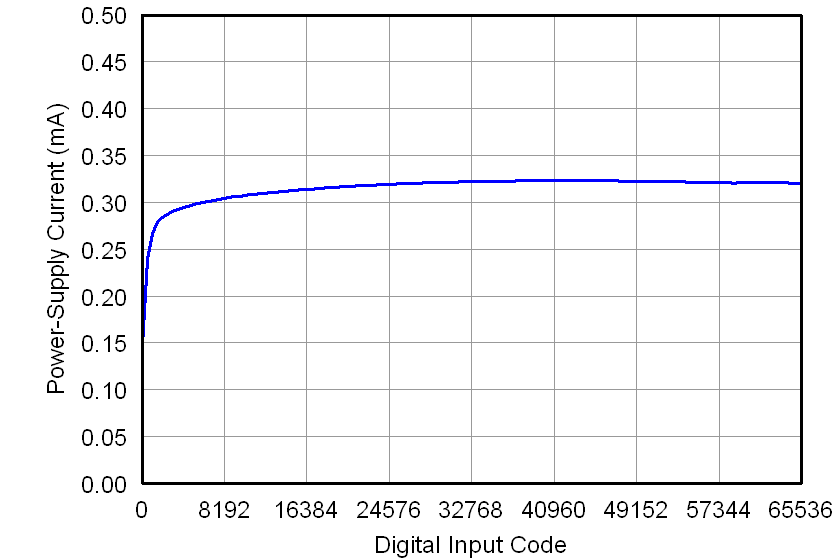
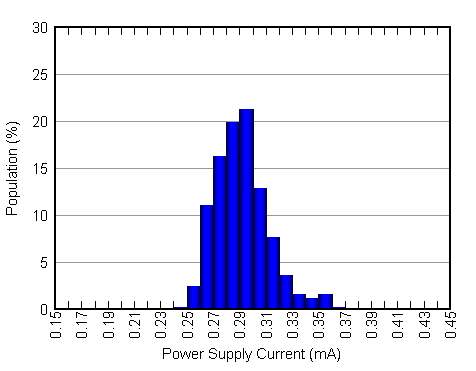
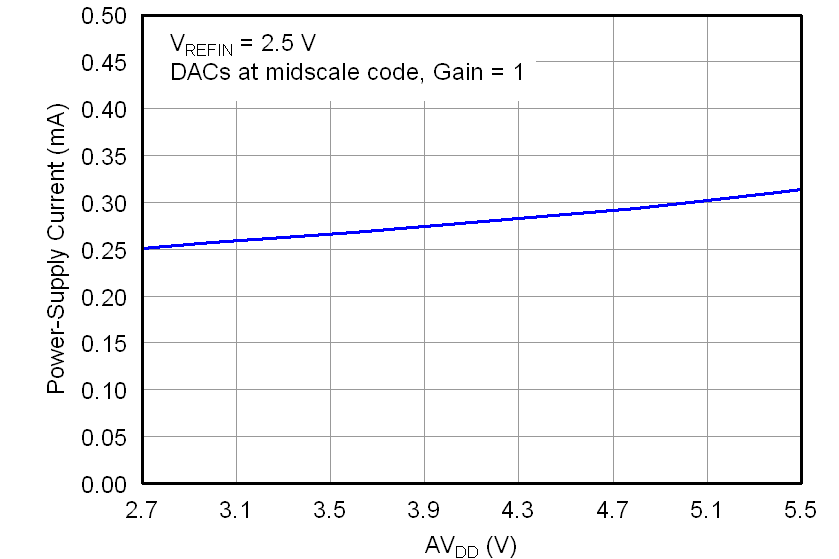
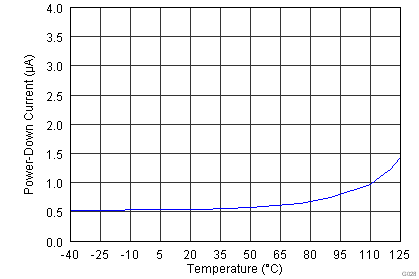
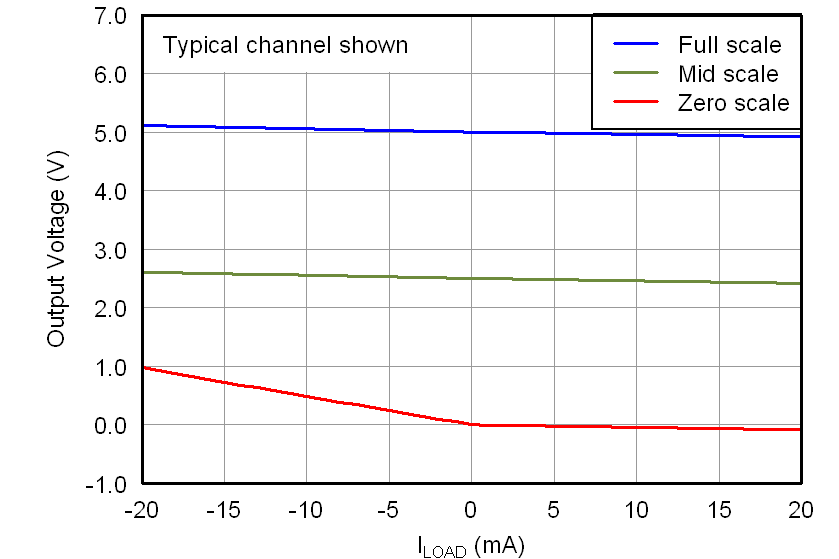
.png)
.png)
.png)
.png)
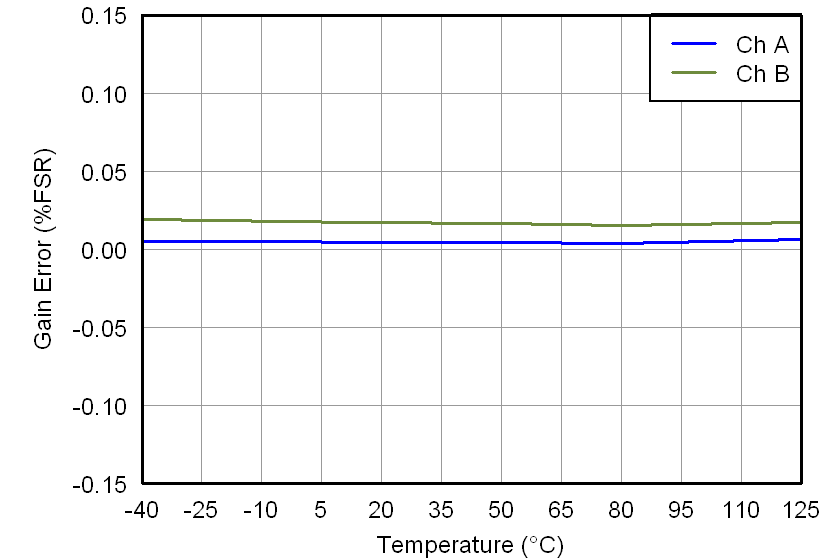
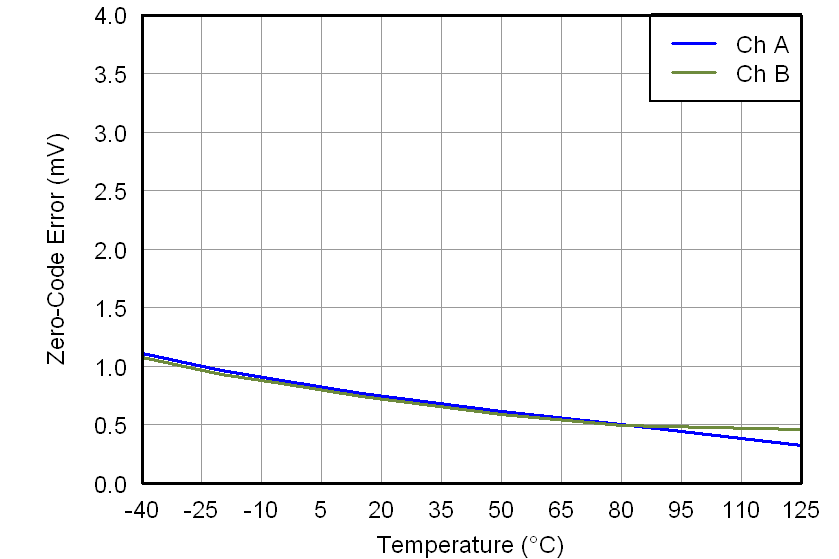
.png)
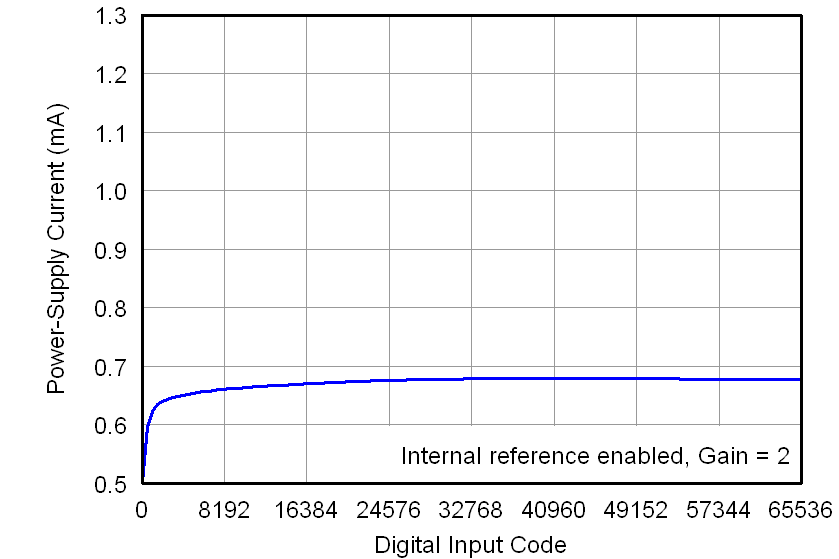
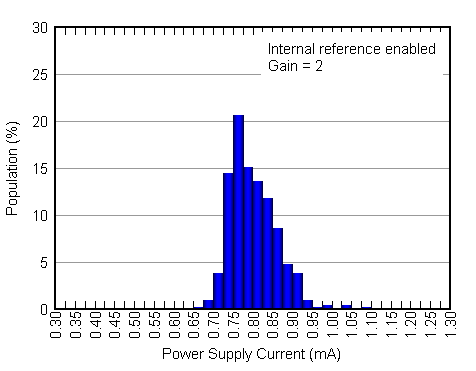
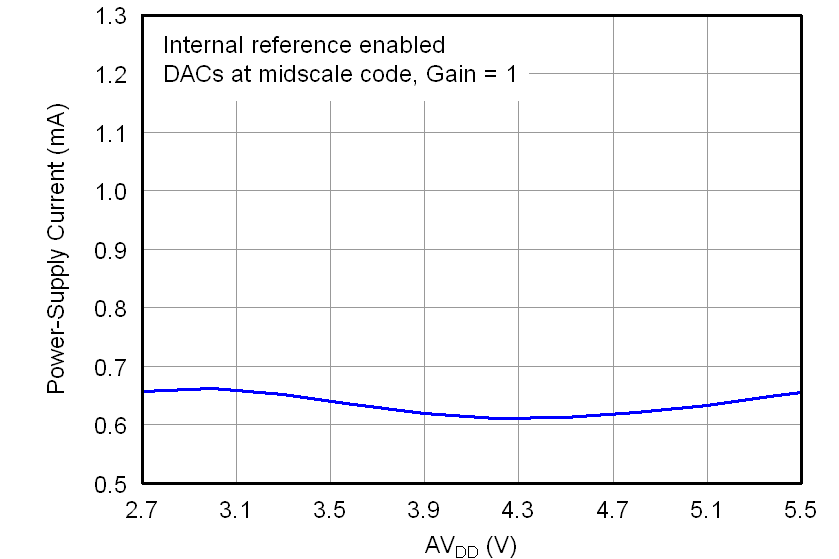
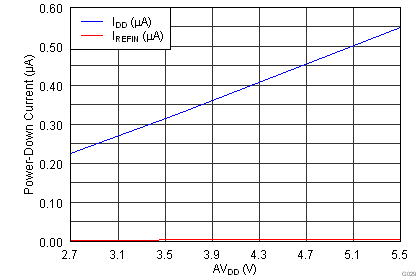
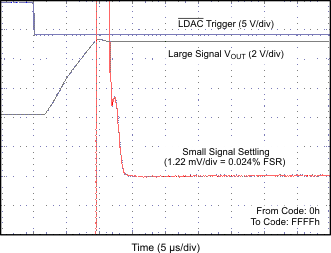
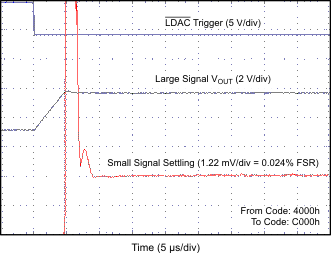
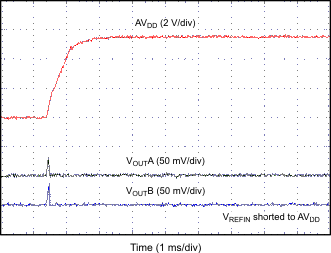
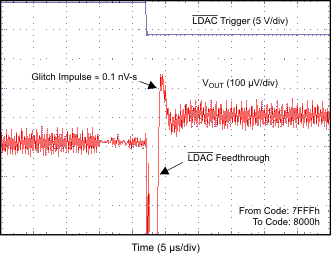
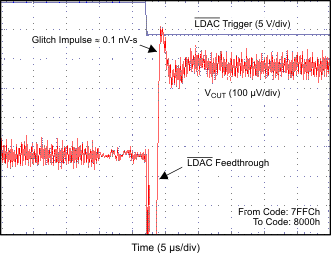
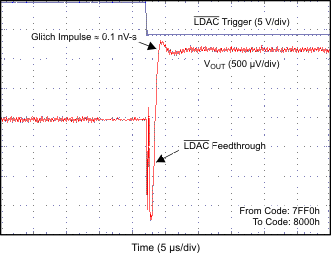
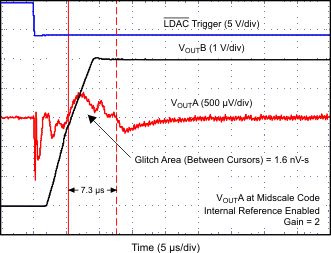
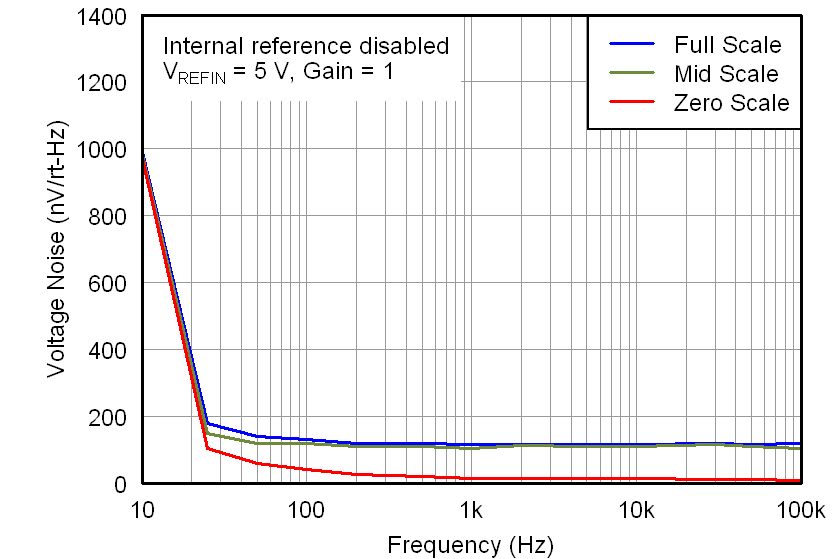
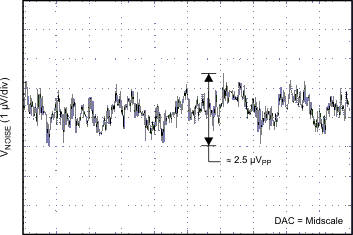
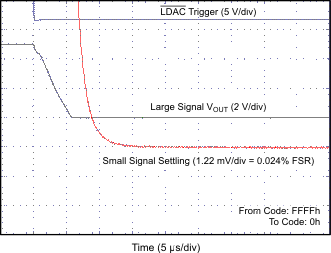
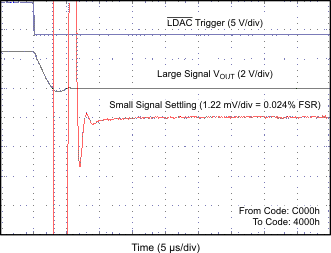
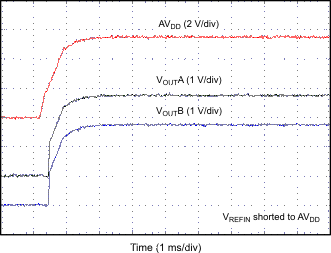
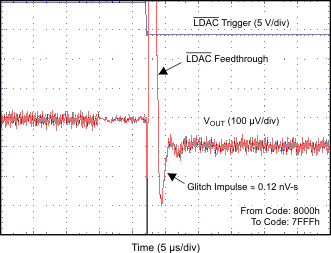
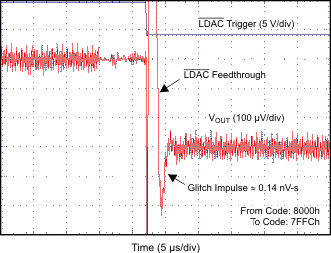
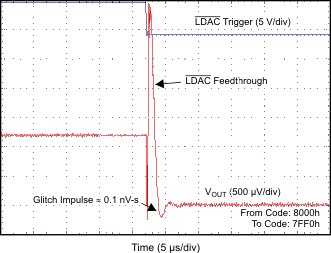
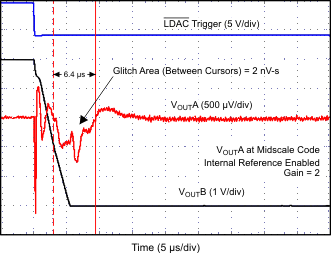
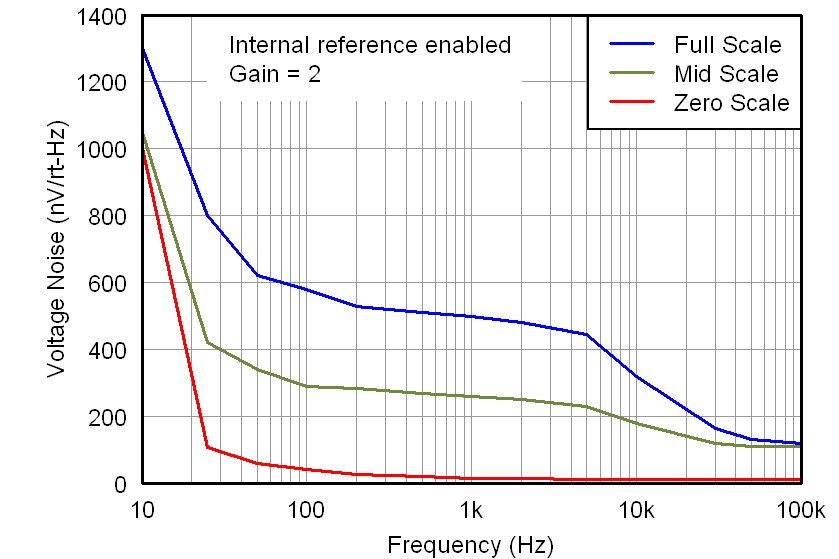
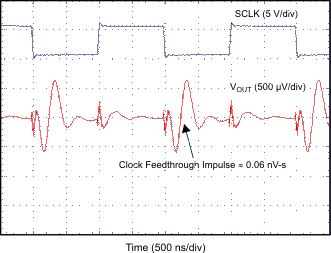
7.7.3 Typical Characteristics: DAC at AVDD = 3.6 V
At TA = 25°C, 3.3-V external reference used, gain = 1 and DAC output not loaded, unless otherwise noted..png)
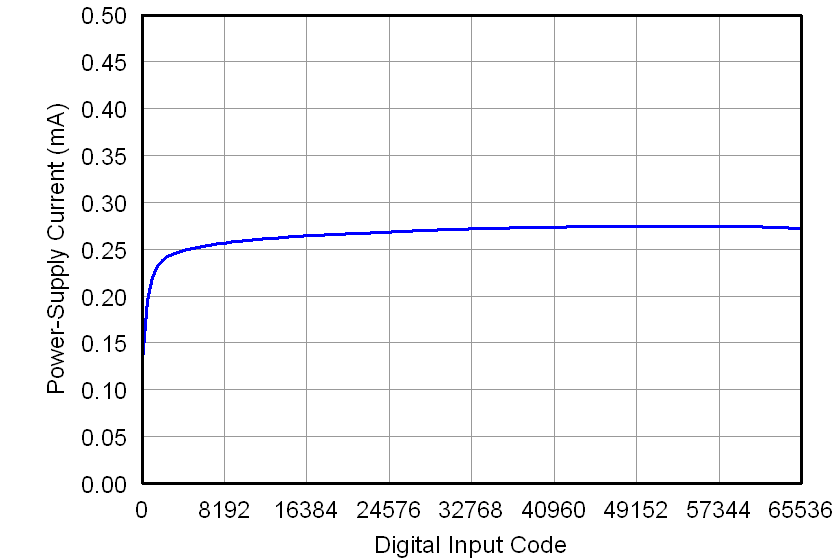
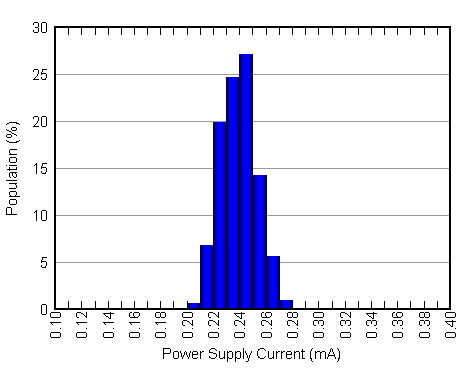
.png)
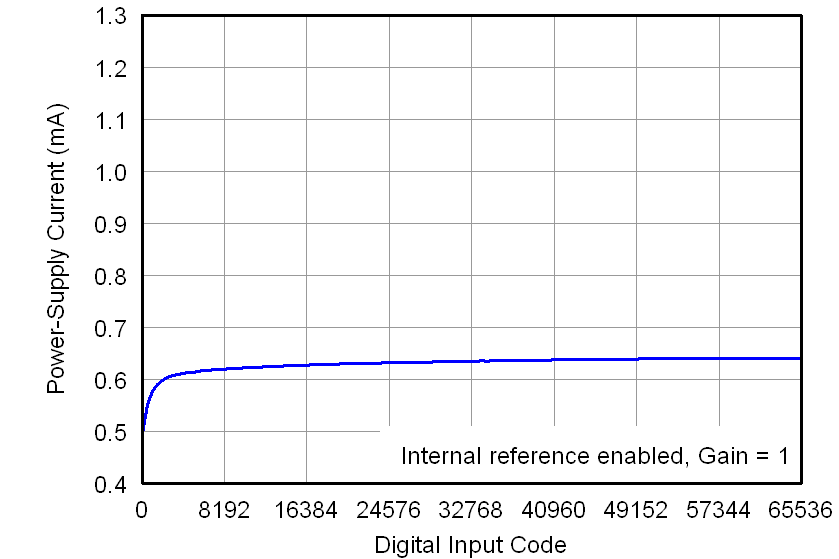
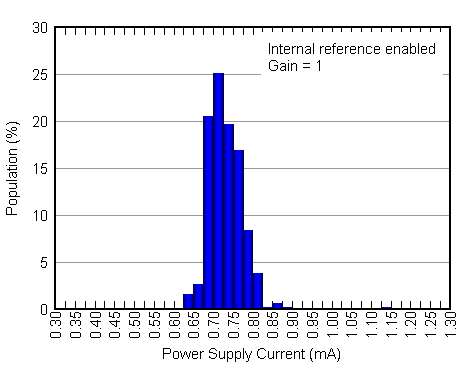
7.7.4 Typical Characteristics: DAC at AVDD = 2.7 V
At TA = 25°C, 2.5-V external reference used, gain = 1, and DAC output not loaded, unless otherwise noted..png)
.png)
.png)
.png)
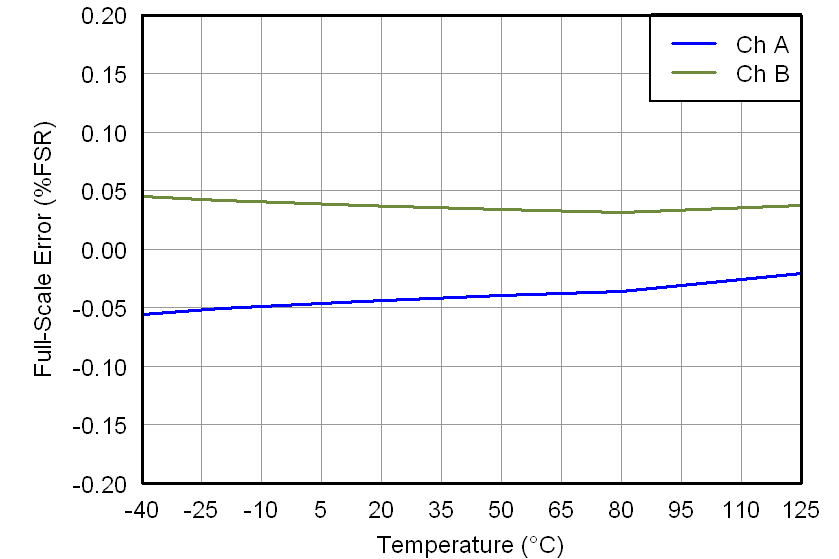
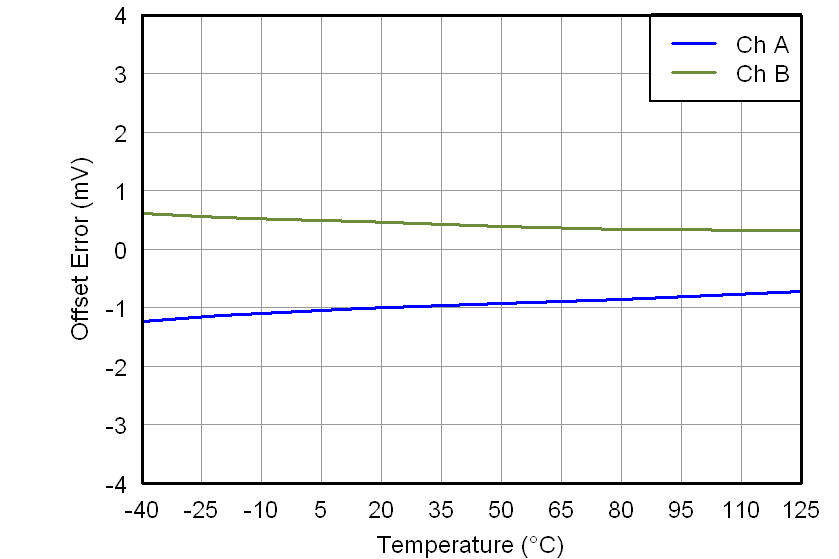
.png)
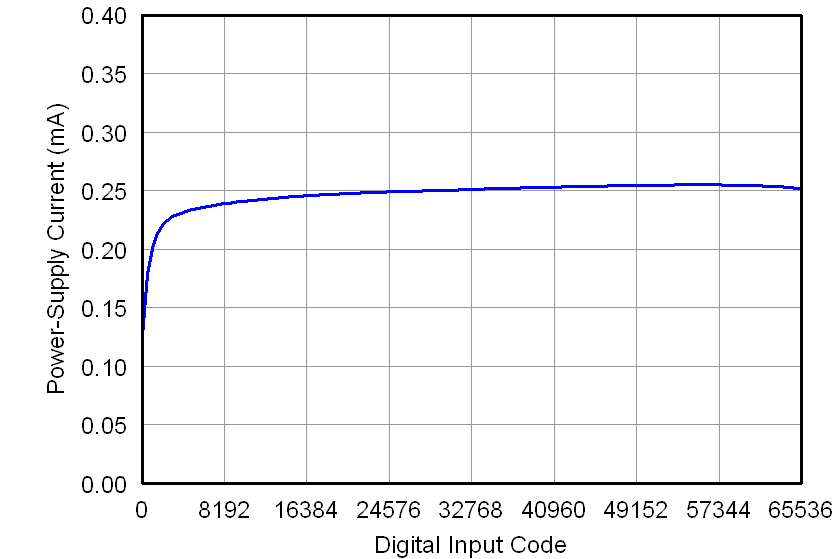
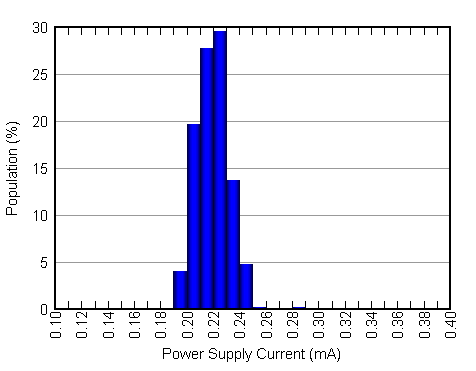
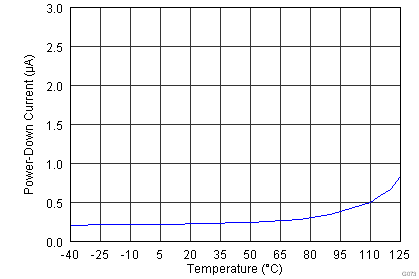
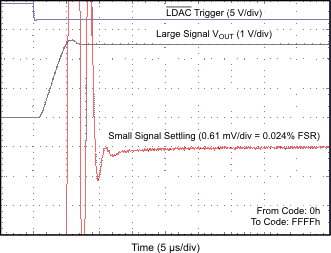
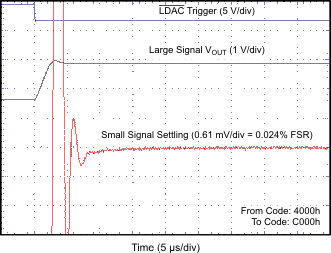
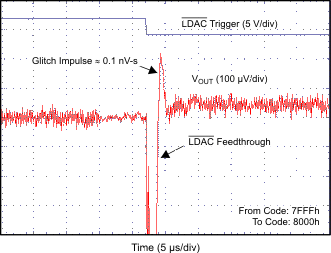
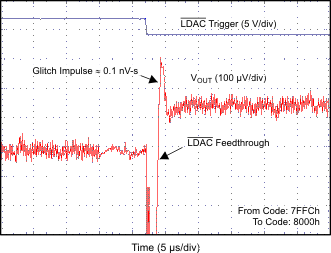
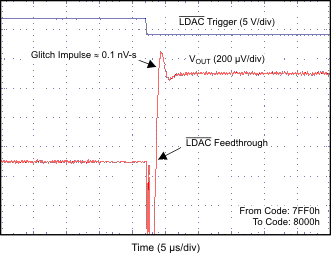
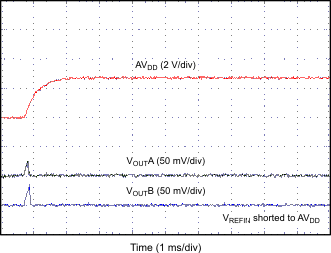
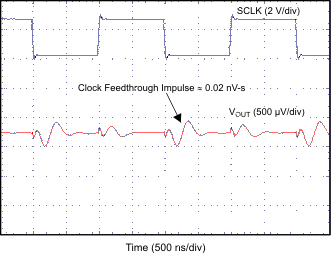
.png)
.png)
.png)
.png)
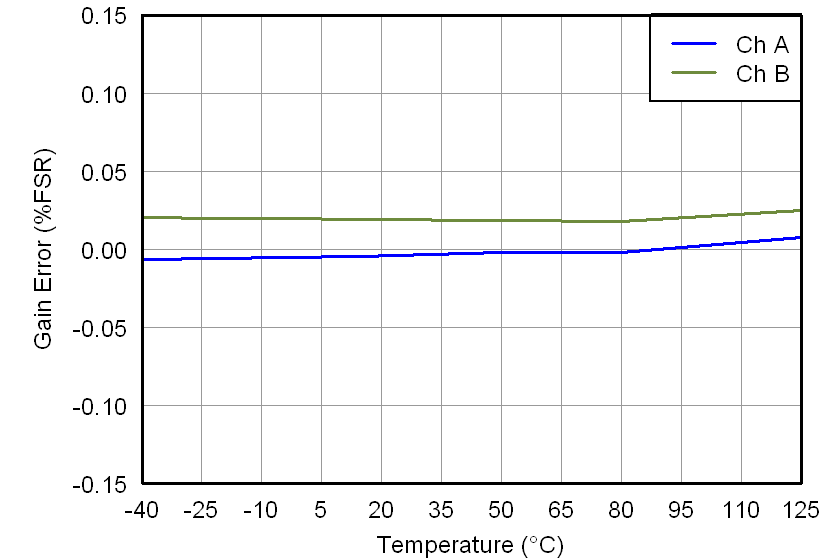
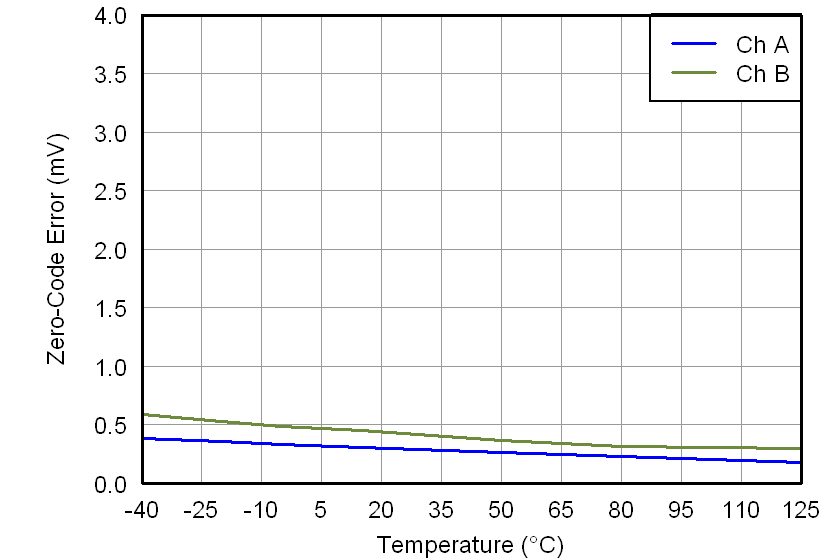
.png)
